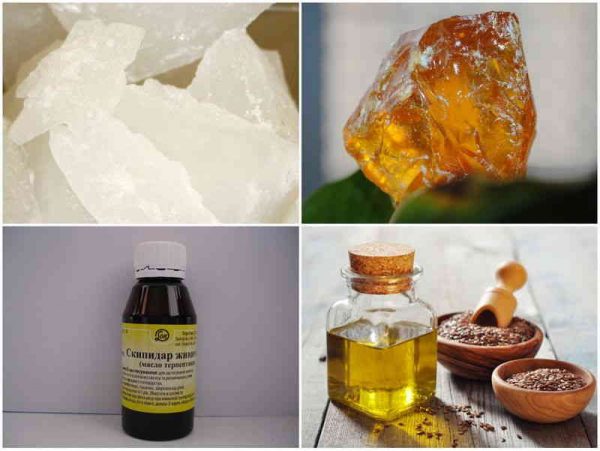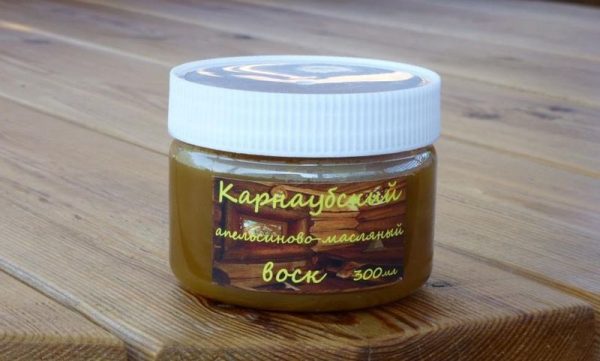Wood has many advantages, but it also has disadvantages. It is a sensitivity to wet environments. Upon contact with the liquid, the untreated wood fibers swell and deform, and after prolonged exposure begin to rot. Is it possible to avoid this? Yes, and oil wax for wood is used for this.
- Benefits of Wax Oil
- Choosing Wax Oil
- Cooking methods
- Wax, turpentine and rosin
- Paraffin, gasoline, rosin
- Wax, linseed oil, turpentine, rosin
- Wax, linseed oil, propolis
- Wax, linseed oil, lard
- We use olive oil
- Jojoba Oil Wax
- Carnauba wax for wood
- Oil Wax Application Technology

This is a composition that is either sold ready-made or made with your own hands. The second option is preferable for those who are not afraid of experiments and would like to try different methods of processing wooden surfaces.
Benefits of Wax Oil
Previously, for the most part, yacht varnish was used for this purpose, and it perfectly protected the wood from the harmful effects of moisture. The composition makes the color of the tree beautiful and saturated, and the structure of the fibers is pronounced.

But varnish has flaws. It is erased and cracked, and therefore it needs to be regularly updated (every 5-6 years, depending on the intensity of operation). Removing the old layer is a complex process, and applying a new coating is associated with considerable difficulties. The varnish is toxic, and therefore precautions must be observed.
Compared with it, oil-wax has several advantages:
- Easy to apply. Even hand-made compositions are easily rubbed into a wooden surface.
- Non toxicity. These products include caustic components, and therefore, when working with them, care must be taken. But most often, wax oil is made from natural ingredients - non-toxic and safe for human health.
- Vapor permeability. If the varnish tightly clogs the pores and all kinds of holes, the oil-wax preserves them. Wood “breathes”, which leads to natural ventilation and prevents rotting processes.
- Practicality. When correctly applied, these formulations provide excellent protection against sudden changes in temperature, humidity and mold.
- Deep penetration. The varnish remains on the surface of wooden products, while oil-wax passes deep into the fiber structure and provides more reliable protection.
If earlier when replacing floorboards you had to remove the entire layer of varnish and reapply, now this can be avoided. You just lay down a new board and cover it with the same composition that was used to process the floor. This provides a uniform structure for the entire coating.
to contents ↑The fibers of the wood during waxing remain free, not constrained. If the floorboards are laid on the underfloor heating system, then when the temperature drops, there will be no cracks on the surface of the tree, since it can increase and narrow in volume without deforming.
Choosing Wax Oil
The key criterion is the composition of the product, which components are included in it. The final result and the tone of the wood directly depend on this.
The tool consists of:
- oils (linseed, olive or jojoba);
- beeswax;
- tinting for color saturation;
- solvent, which makes the product not so thick (the smaller its mass fraction, the faster the hardening proceeds).
If you buy a ready-made product, then make sure that there are no aggressive solvents, as well as benzene. It is necessary to take into account the type of wood, since both the absorption rate and the expense of the product directly depend on this. On sale there are compounds for hardwood, soft and exotic woods.
Oil-wax often contains additives that make the surface glossy and shiny. It looks spectacular, and such a tool is suitable for interior work. But be careful, as the coating becomes slippery when processing with a compound.
to contents ↑Cooking methods
It's time to talk about how to cook oil-wax at home and what components are required for this. For greater convenience, we will give the mass fraction of the ratio of ingredients. Stick to this recommendation and you will be able to prepare a quality product for the treatment of wooden coatings.
to contents ↑
Wax, turpentine and rosin
This composition is ideal for furniture, because it allows you to create a special protective film, thanks to which dust does not harm the surface of the tree, a characteristic coating does not form on top.
This was made possible by the addition of turpentine. It makes the composition not so thick that it simplifies application and allows you to work with the surface as much as you need.
Ratio:
- beeswax - 4 parts;
- gum turpentine - 2 hours;
- rosin - 1 hour
It is necessary to melt the wax to a liquid state, add crushed rosin. Mix the components and wait until they completely dissolve, then pour in turpentine and mix.
to contents ↑Paraffin, gasoline, rosin
This compound is suitable for outdoor use. If you have a wooden terrace, a gazebo, a bench and a canopy, then it will protect them from the harmful effects of external factors. The product contains gasoline; it is used in places where there are no high environmental requirements.
Ratio:
- paraffin - 55%;
- refined gasoline - 40%;
- rosin - 5%.
Gasoline can be replaced with purified acetone. It costs more, but disappears faster without leaving a smell. When preparing the product, observe safety measures, especially when melting paraffin. Keep a container of gasoline away from fire.
to contents ↑It is better to cook the product outdoors, which will help to avoid the concentration of vapors. If this is not possible, and you are forced to mix the ingredients at home, then take care to ventilate the room.
Wax, linseed oil, turpentine, rosin
A popular tool for processing small wooden products. These are small furniture, dishes, all kinds of wood crafts and so on. It affects the large consumption of materials, which is associated with considerable financial costs.
Ratio:
- beeswax - 25-30%;
- refined linseed oil - 35-40%;
- turpentine - 20-30%;
- rosin - 5%.
If there is no linseed oil or it is expensive, you can replace it with olive or sunflower. Make sure that it is clean and free from impurities or any kind of sediment, as this will degrade the quality of the composition. All ingredients are mixed with each other and heated, after which the product is ready.
to contents ↑
Wax, linseed oil, propolis
Propolis is used not only for medical and cosmetic purposes. Its composition enriches wood, making it “lively” and strong. Propolis is known for its penetrating properties and adhesion to wax, so the mixture is high-quality.
Ratio:
- beeswax - 1 part;
- linseed oil - 4 hours;
- propolis - 2 hours
The downside is high cost, which is due to the price of propolis itself. If nevertheless you decide to cook it, then make sure that linseed oil is cleaned, because otherwise unnecessary impurities will appear in the composition.
The cooking technology is simple and straightforward. The wax and propolis melt, after which oil is poured into them, and the whole mixture is thoroughly mixed. This tool is suitable for processing wooden utensils.
to contents ↑Wax, linseed oil, lard
Shabby pork fat is also great for wood processing. It affects the increased fat content, which creates a protective film. In its pure form, no one will rub floors or wooden utensils with grease, so it is used as one of the components.
Ratio:
- beeswax - 3.4 parts;
- linseed oil - 10 hours;
- smalets - 1 hour
Mixtures based on overheated lard or propolis have almost the same effect, but come out with lard much cheaper. In both cases, the composition should be applied at least 2 times, waiting for the first coat to dry thoroughly. This will help to achieve the desired result.
to contents ↑
We use olive oil
Another popular and easy-to-cook recipe that comes in handy when processing wood. To do this, you will need:
- olive oil - 7 tablespoons;
- beeswax - 2 tablespoons.
You need to take the wax and crumble it thoroughly, and then knead it into a homogeneous mass. After that, it is mixed with olive oil and infused in a water bath. The mixture must be melted, then removed from the heat and stir until it becomes homogeneous.
to contents ↑Such a composition is stored in a glass dish with a lid, because when it comes in contact with air, it will begin to harden and lose its properties.
Jojoba Oil Wax
If you find this wonderful oil, then consider yourself lucky! It has amazing properties and is beneficial for wood. A mixture based on this oil protects the fibers from deformation and prevents them from swelling.
Components:
- pressed jojoba oil - 150 mg;
- beeswax - 50 mg.
When preparing the composition, it is necessary to observe the proportions - 1: 3. This will help achieve optimal consistency and preserve the natural properties of the oil.
The components are melted in a water bath and mixed thoroughly. The composition is stored in a glass jar for up to 2 years, it does not lose its properties. Therefore, you can periodically use it to update and strengthen the wood cover.
to contents ↑Carnauba wax for wood
Last, but not least, the recipe will surely interest you. Today on sale you can find carnauba wax. It has miraculous properties and perfectly affects the state of wood: strengthens it, makes the fibers stronger and immune to moisture.
The great difficulty in preparing a product based on carnauba wax is that it melts at a high temperature, and therefore it is mainly used for making mastic at home.
For the product you will need:
- place the carnauba wax flakes in a metal container, cover with a lid and heat over low heat;
- add oil (linseed or hemp) in a ratio of 2: 1 (that is, 2 parts of oil per 1 part of wax);
- heat the mixture until it melts;
- stir well;
- pour into a glass container.
With prolonged storage, the resulting mastic hardens. You will have to reheat it to a liquid state and add a small amount of purified oil, after which you can safely apply it to wood.
to contents ↑Oil Wax Application Technology
How to apply the prepared product on a wooden surface? It is necessary to completely clean the product. There should be no small debris, no dust, no paint, no pollution. The same applies to greasy spots.

The mixture is applied with a brush. Make sure that her stubble does not fluff and does not leave villi on the surface. Oil-wax is applied in a thin layer over the entire coating of the product, and the formation of sagging and seams should be avoided. The surface should be uniform and smooth.
Thick products often leave excess on the bristles of the brush, which quickly harden. This is how clots form.If you notice this, then periodically wipe the brush, remove clods.
After applying the first coat, let it dry completely. Take your time and be patient. If you do not wait a sufficient amount of time and begin to test the wax, then fingerprints will remain on the surface.
The above procedure needs to be done 2-3 times. So the wooden surface can be impregnated with the solution, and its components penetrate into the inaccessible small cracks, filling them and protecting them from moisture.
Polishing a wooden surface can be done with ordinary cotton cloth. If at home there is a grinding machine, then use it, but avoid abrasive disks and materials, as they will damage the surface of the tree and leave characteristic marks and scuffs on it.
The processing procedure is not difficult. A little practice, and you can apply oil-wax to wooden products.













